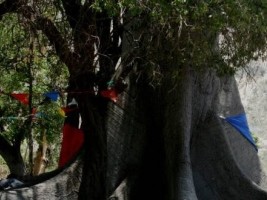|
||||||||||||||||||
|
|
iciHaiti - Environment : Plantation of 400 «mapous» at the National Botanical Garden 25/12/2017 06:17:05
Through this initiative, it was a question of performing a dual function of the Botanical Garden: i) Conservation of biodiversity and rehabilitation of ecosystems; ii) The heritage enhancement of trees with cultural value in particular, especially the mapou. Note that the National Botanical Garden of Haiti is located in Ganthier, 2nd section Balan, National Road #8, between Source Zabeth and Bois Frèch. Learn more about Mapou : The Mapou Ceiba pentandra also known as Fromager, "Fwomajyé, mapou wouj" in the French West Indies, Kapokier or Kapok tree wood cotton, is a large tree of the tropical zones, originating from South America, Central America and the West Indies, producing a vegetable fiber rot-proof, named kapok. But since the 1940s, this majestic tree, Haiti's largest in terms of size (up to 30 m high), has almost completely disappeared from the arboreal landscape of the national territory. However, it has the virtue of retaining the soil, to facilitate the feeding and filtration of water tables (phreatic), to serve as a remedy (medicinal plant), to refresh and sanitize the environment and to ensure the habitat of several species of birds, insects and small animals by also providing protection against certain predators. See also : https://www.haitilibre.com/en/news-22543-haiti-environment-where-are-the-botanical-gardens-of-the-state.html https://www.haitilibre.com/en/news-20305-haiti-environment-national-botanic-garden-signature-of-partnership-agreements.html https://www.haitilibre.com/en/news-20298-haiti-environment-a-70-hectare-botanical-garden.html https://www.haitilibre.com/en/news-20266-haiti-environment-launch-of-the-work-of-the-national-botanical-garden.html S/ iciHaiti
|
|
Why IciHaiti ? |
Contact us |
Français
Copyright © 2010 - 2026 IciHaiti.com |


